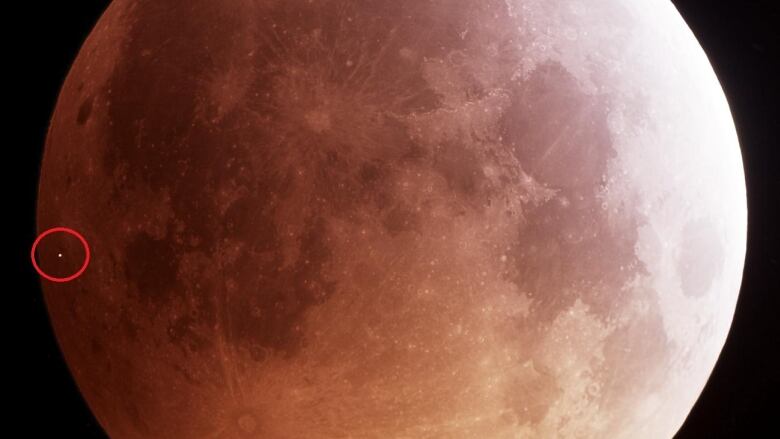Meteoroid seen slamming into the moon during total lunar eclipse
Object likely left an impact larger than 1 metre in diameter, scientist says

Several people around the world have captured an event that is rarely witnessed: a meteoroid slamming into the moon.
The total lunar eclipse was enjoyed by people across Canada, some enduring chilly winter temperatures to catch what became known across social media as the "super blood wolf moon."
Initially, someone posted on Reddit about the potential of a lunar impact captured in one of his images.
A lunar impact appears as a bright spot in a photograph. However, when doingastrophotographyimaging the night skythere's always the possibility of a badpixel in the digital camera causing the spot. But it soon became evident that others had also managed to photograph the event as others began sharing their images and video.
The impact took place at11:41 p.m. ET Sunday
ChristianFroschlinmanaged to capture the impact from his 15th-floor balcony in The Hague, the Netherlands.
"I didn't see it either visually or on screen. I was busy recordingthe entire thing from start to finish,"Froschlin said. "Once I saw there was an impact candidate I looked in my own data and found it at the predicted time and location."
Full Image and Crop. This is stretched since it was rather dark but I have raw sensor data + dark frames for this however no flats. There is mag 8.5 star HIP 39869 in upper left corner as brightness reference. pic.twitter.com/kxWJvZwRzG
—@chrfrdeThere is a lot of leftover debris from the formation of our solar system. Much of it is grain-sized, what we see burn up in our atmosphere as meteors. Larger ones can sometimes reach the ground, and they are then called meteorites. There are also asteroids, which are much larger, some hundreds of kilometres in diameter.
But because the moon lacks any significant atmosphere, the larger bits of debris slam into it violently. These types of impacts are responsible for the craters on the lunar surface.
Justin Cowart, a PhD candidate and Martian geologist at Stony Brook University in New York, estimates the object was several metres across and could have created an impact crater of several meters or larger in diameter.
This event was much fainter than that so I'd guess the crater is in the 1-10 m range.
—@jccwrtHowever, more data is needed to confirm that, and NASA is likely to use the Lunar Reconnaissance Orbiter to better locate the site and determinethe size of the crater.












_(720p).jpg)


 OFFICIAL HD MUSIC VIDEO.jpg)
.jpg)



























































































